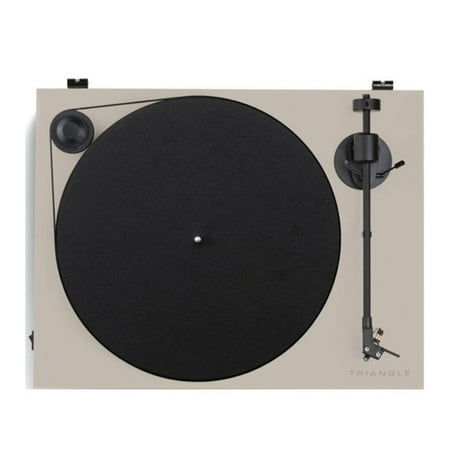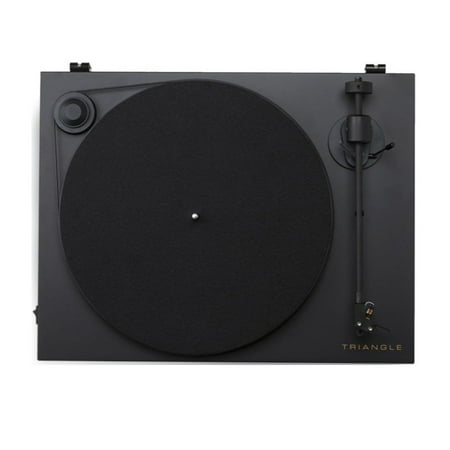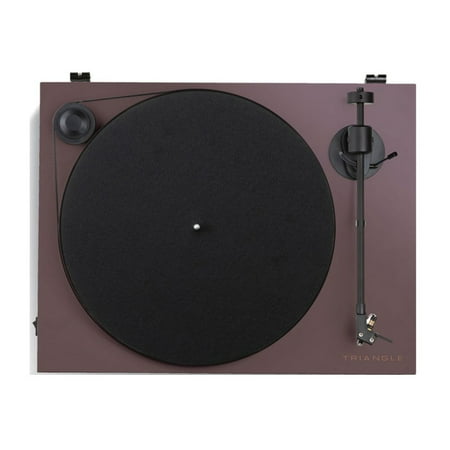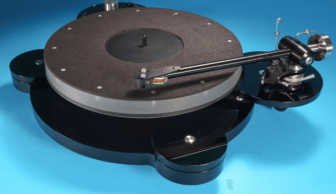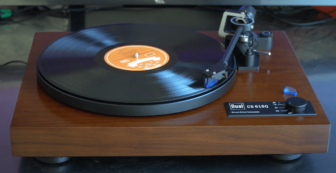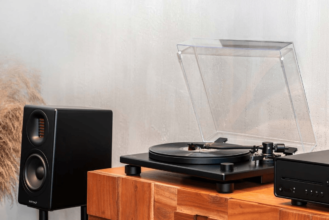Triangle turntable review – Project Management
Triangle team up with Pro-Ject for their first vinyl spinner. John Pickford reports.

I knew in advance that Triangle’s first foray into a vinyl replay was in collaboration with a highly respected turntable specialist. However, I was surprised when it turned up in a box bearing the Pro-Ject logo.
Unboxed, the turntable looked smart enough with a traditional minimalist design and the Triangle logo in the bottom right-hand corner. But hang on, what’s this? Bang in the middle of the dust cover was another logo, but this time, it was the same as the one on the box: Pro-Ject.
The deck came with a tonearm ready-mounted, and its headshell was equipped with an Ortofon OM- 10E cartridge. It’s not quite plug-and-play, though, as you still have to mount the platter and attach the drive belt. Of course, it’s sensible not to ship a turntable with its platter in place, pressing down onto the bearing; however, fitting
“With the tonearm I noticed the lack of bias compensation”
the drive belt was a bit of a faff. This wasn’t helped by the fact that the platter does not have a groove in its periphery. I’ve plenty of experience attaching drive belts yet this one took several attempts before it was in place; a vinyl-loving novice would have a real struggle with this, I thought.
With my attention turning to the tonearm, I noticed the lack of bias compensation and was a little surprised to see the counterweight almost dangling off the end; I would have thought it better designed to be closer to the pivot.
Although the arm is made of aluminum, in use, it felt on the flimsy side of things, and there was unacceptable flex in the armrest.
Looking on the bright side, the phono cable is Pro-Ject’s Connect it E, which is far more substantial than the thin, red, and white plastic phono-equipped cables I might have expected to see attached to a tonearm like this. It features gold-plated RCA connectors. No exotic material is used for the platter, though; it is just MDF with a standard black felt mat.
There’s no switch for selecting 33 or 45 rpm – you have to manually adjust the drive belt – and the power switch is located on the side of the plinth, which does at least preserve the minimalist yet stylish look of the unit. Despite this, the basic design and uninspiring tonearm ultimately made the turntable feel like – if you’ll forgive the pun – an unfinished project.
Following an enjoyable experience streaming hi-res audio into Triangle’s Twin AIO loudspeakers, I hooked up the turntable and played Scott Walker’s It’s Raining Today from Scott 3 (Philips 1969) as it was the last track streamed through the AIO system.
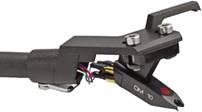
The tonearm comes equipped with an Ortofon OM-10E cartridge.
I have to admit my expectations weren’t exactly sky high for the turntable’s sonic abilities, however I was still underwhelmed. Scott’s reverb-soaked vocals were robbed of atmosphere while the strings and hand-held chimes lost their sparkle: a disappointing result.

The turntable is identified as RCA in the app, denoted by a pair of phono sockets. The Line input is via a 3.5mm stereo jack plug.
At the price, Triangle’s Turntable does not represent particularly good value for money, and you can do far better elsewhere. Pro-Ject’s Essential III A has a similar-looking design and comes in a classy, high-gloss finish. The tonearm is more solid looking, and features bias compensation and the OM 10-E equipped deck can be yours for well under £.
Audition the Triangle Turntable with the Twin AIO system if all your components display the same company logo. But be aware it still says Pro-Ject on the lid.
MEASURED PERFORMANCE
The Pro-Ject turntable was remarkably speed stable, Wow&Flutter measuring 0.12% (DIN wtd). There was a peculiar flutter peak at 5Hz under analysis but very little basic speed wander, so no subjective ‘drunkenness’ or vagueness of pitch. Speed was accurate, too, at +0.2% fast. Overall, it was a surprisingly good result since speed wander is common in budget belt drives, generating impulsive wow especially.
The 0M10 cartridge fitted was set to track at 1.8gms, right at the top of Ortofon’s recommended 1.25-1.75gm range. Its tracking was so poor as to need this, and the absence of bias correction in the arm did not help. Ortofon claim 70 muym tracking, but we measured 45 muym (CBS STR-112 test disc), with obvious mistracking at 60pm. In the midband (1kHz) results were even worse, just 10cms/sec being cleared on B&K QR-2011 test disc. The suggestion here is that the 0M10 – an old design – will mistrack on vocals.
Frequency response falls slowly toward high frequencies, so it will have a soft sound. This can be brightened slightly by increasing load capacitance to 400pF.
This cartridge is past its sell-by date: modern budget designs like Ortofon’s 2M Red or Audio Technica’s AT-3600L (also in this issue) manage far better.

VERDICT
When you purchase through links on our site, I may earn an affiliate commission. Here’s how it works.
SCV London (UK distributor)
www.scvdistribution.co.uk
+44 (0)3301 222500
New U-Turn Vs Triangle/ProJect Turntable…Or Go Vintage?
Link to join the MOD Patreon and enter the turntable drawing: https://www.patreon.com/myowndevices Entry period ends midnight ...





